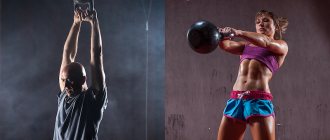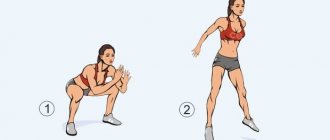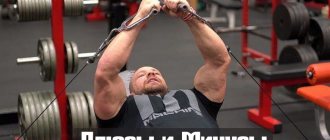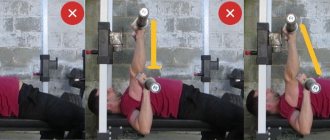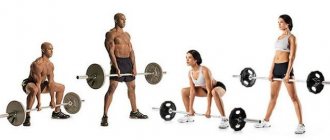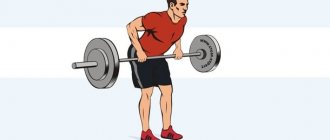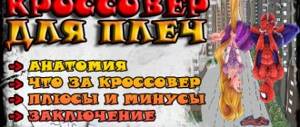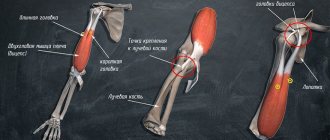Rice. 3-3. Metal electrodes are used to record an electrocardiogram. The electrode on the right leg acts as a ground to prevent interference from AC power.
The electrical processes of the heart can be projected onto the torso and limbs. For this reason, an electrode placed on the right wrist registers the same electrical voltage as on the right shoulder; tension in the left wrist or other area of the left arm corresponds to tension in the left shoulder.
Finally, the voltage on the electrode placed on the left leg is comparable to the voltage on the left thigh or groin area. In clinical practice, electrodes are attached to the wrists and ankles simply for convenience. Obviously, to record an electrocardiogram in a patient with a limb amputation or a plaster cast, it is necessary to place electrodes near the shoulders or groin, depending on the circumstances.
There are standard bipolar (I, II, III) and enhanced (aVR, aVL, aVF) limb leads. Bipolar leads were so named historically because they record the electrical potential difference between two limbs.
Benefits and disadvantages of bringing hands together in a block
- The first thing you should pay attention to is the minimal risk of injury.
- Secondly, this is a narrowly targeted load, that is, during work, the pectoral muscles receive the lion's share of the load, which makes bringing the arms together a highly effective exercise.
- Another advantage of bringing your arms together in a crossover is the creation of high-quality muscles. The appearance of the pectoral muscles becomes more symmetrical and more aesthetic from the information.
- During the exercise, there is no load on the spinal column and joints of the body, except for the shoulder ones, so it is suitable for both men and women, as well as minor athletes.
- Block exercises are excellent for working the central part of the pectoral muscles.
I Superset
Close-grip push-ups and bent-over dumbbell rows on a fitball
10 reps + 15 reps
Technique for performing push-ups with a narrow grip:
These push-ups primarily work your triceps, but also give a good workout to your chest and core, making them a great exercise for an overall fat-burning boost. If you cannot follow proper form in the straight plank position, then you can do these push-ups from your knees.
Start in a straight-arm plank position. Keep your neck in a neutral position, looking straight at the ground.
Slowly lower your body toward the floor until your elbows are bent 90°. Return to the starting position and straighten your arms.
Technique for performing bent-over dumbbell rows on a fitball:
The dumbbell row is a great exercise for working your arms as well as one of your largest muscle groups, your back.
Place dumbbells in front of an exercise ball and lie with your chest on it. Straighten your arms to reach the dumbbells.
Now pull the dumbbells up toward your shoulders with your palms facing inward. Extend your arms and then lower the weight to the floor under control.
What muscles work when bringing your arms together in a block?
The main muscles involved in the work are the pectoralis major muscles. The load also goes to the abdominal muscles and latissimus dorsi muscles. The biceps and anterior deltoids receive a small share of the load.
Tips for Maximum Productivity
Let's reiterate the important points:
- Work with the correct technique, performing movements using the rear deltas.
- Do not make sudden jerking movements. Take care of your shoulders!
- Eliminate the trapezoid from the movement. In order to do this, you need to move your shoulders forward, thereby stretching it across your back.
- If the rear deltas are lagging behind in development, then start shoulder training with them.
- Use dumbbell crossover exercises to correct imbalances between the right and left sides.
- Start training your deltoids with heavy basic exercises. Leave the isolated ones for last.
I hope the article was useful to you. Train your rear delts the right way.
Good luck to everyone in your training!
Crossover exercise options for the pectoral muscles
Bringing your hands together in a crossover in front of you
This option involves symmetrical load distribution. That is, when bringing your arms together in front of you, the emphasis does not apply to the bottom or top of the pectoral muscles, but is evenly distributed over all areas of the muscle. With this technique, the latissimus dorsi muscles are not involved in the work as load stabilizers.
The athlete must choose the right position in the crossover to be not only in the center of the frame, for symmetrical tension of the cables, but also for maximum stretching of the pectoral muscles.
The technique for performing the exercise is as follows:
- Your feet should be shoulder-width apart, your knees slightly bent, and your torso leaning slightly forward. It is generally accepted that one leg should be placed further forward. But this is a highly controversial point. Yes, this position will add stability, but there will be an imbalance in symmetry, which will negatively affect the uniformity of the load.
- The movement begins from the starting position when the hands are brought together.
- During the return movement while inhaling, the arms move to the sides parallel to the floor. Elbows should always look to the sides. The movement is carried out in the same plane with the shoulders.
In general, this exercise is analogous to dumbbell flyes while lying down or hands in a butterfly exercise machine; accordingly, the movements in the crossover will be identical. While stretching the muscles, the athlete inhales, and while tightening, exhales.
Reduction of hands in a crossover from the lower block
The lower version of the exercise emphasizes the load on the upper part of the pectoral muscles. Also, a noticeable load falls on the anterior bundles of the deltoid muscle. While performing this exercise, you should pay attention to your back.
- The case in this version must be in a vertical position.
- Hold the lower blocks with your hands.
- As you exhale, bring the handles together in front of you, bringing them to the level of your chin.
- When bringing the blocks together, turn your palms upward. Make sure that your elbows point toward the floor at the peak of their amplitude. And the arms remained bent at the elbows.
- As you exhale, lower the blocks and move your arms to the sides.
Bringing the hands together in a crossover from the upper blocks downwards
This option is aimed at working the lower part of the pectoral muscles. It is performed like bringing your hands together in a crossover in front of you, but the movement is from top to bottom.
- While performing the movement, bend your arms slightly at the elbow joints and tilt your torso forward.
- During the exercise, concentrate on working your pectoral muscles.
- At the top point of the amplitude, the arms are located to the sides.
- Exhale as you move downwards, bringing your hands together at the lowest point.
Reduction of hands in a crossover while lying on a bench
This exercise is very similar to the technique of performing dumbbell flyes on a horizontal bench. Loads the pectoralis major muscles evenly.
- To perform a bench press, the athlete must take a lying position on a bench located under the crossover.
- The handles should be located at the level of the athlete’s shoulders.
- When performing this variation of the hand pinch, it is important to tense your chest muscles and bring the handles together in front of you with your arms outstretched.
- Your arms should be slightly bent at the elbow joints. Elbows point to the sides.
- The legs should be spread wide apart and provide support.
This version of the exercise is as simple and safe as possible.
Common mistakes
Pulling the weight with a jerk . Take pity on the shoulder joint; with a jerky movement, you can damage it.
"Throwing" weights . If you don't consciously lower your hand, but let it fall without any resistance to the weight, this is a sure way to pull the ligaments. It will take a long time to heal, several weeks. In addition, the negative phase of the repetition is very important for muscle formation. It is here that the damage to the muscle fibers occurs, which is necessary for their thickening and strengthening to occur during the recovery phase. That is, by throwing weight, you deprive the exercise of its effectiveness by at least half.
Fully straightened arm . Here you overload the elbow joint, especially if you straightened it before the latter was blocked. In general, very few exercises require completely straight arms, so always leave your arms slightly rounded.
Bent arm . You make your work much easier because the range of motion becomes somewhat smaller. But the middle bundle of the deltoid muscle, which we aimed at pumping, does not contract sufficiently - you are doing empty work.
The movement of the hand is not in the lateral plane . If you move your hand forward a little, the exercise will become easier, because the load will partially shift to the front deltoids. And they are used to doing quite a lot of work, especially if you, like many gym goers, often bench press. However, you won’t work through the middle ones properly, and the meaning of the exercise will be lost.
Taking too much weight in an exercise . It is this that leads to the fact that you cheat by connecting other muscle groups, which means removing the load from the target one.
Recommendations for implementing the exercise
When performing this exercise, you should pay attention to some important nuances.
- The first is to perform the exercise in a symmetrical position. Most trainers recommend placing one leg forward when performing the exercise to securely support the body. But in fact, in this case, the balance and load on the muscle on the side on which the supporting leg is located is disturbed. The shoulders, pelvis and legs should be in the same plane and should not be turned in any direction. Only in this position can you create an optimal symmetrical load on the pectoral muscles.
- The second point is the maximum stretch of the muscles at the top point of the range of motion. To do this, the athlete must choose a position in the crossover, positioning himself closer or further from the line of attachment of the blocks.
- The third important point is maintaining a pause at the lowest point of the amplitude, in the phase of maximum muscle tension and concentration.
- The fourth nuance is a straight back and a chest filled with oxygen. You cannot perform movements with a sunken chest or slouch. Thus, if the fourth rule is observed, the pectoral muscles are stretched as much as possible, and accordingly, the contraction occurs more efficiently.
- Girls should perform the exercise with minimal weight, and only after mastering the basic basic exercises. Perform 15-20 repetitions for 3 sets. Read more about chest training in the gym for girls →
- Men should work on their muscles in a crossover in the range of 12-15 repetitions for 3-4 sets.
Arm workout with dumbbells to reduce volume and improve muscle tone
It is a common misconception that you can lose weight in the arm area by doing only isolated exercises. And that only biceps curls and reverse push-ups will help you get your arms in order.
However, the best strategy is to do a well-balanced workout that targets all muscles: legs, core, upper body, and cardio. This, along with a healthy diet, is the key to reducing not only your arm fat percentage, but to toning your entire body.
Don’t be alarmed that this home complex may seem like it’s only aimed at quickly pumping up your hands. As soon as you start doing the exercises, you will immediately realize that your whole body is working.
For best results, do this workout program at least 3 times a week, making sure to include leg and butt exercises as well.
Equipment:
- 1 fitball
- 1 pair of 10-pound dumbbells (Note: You may want to use heavier weights on some exercises and/or lighter weights on others—choose based on your physical capabilities).
To do this workout you need:
- Perform all repetitions of each superset (pair of exercises) in a row without stopping.
- Rest 30 seconds between each superset.
- Rest 2 minutes after completing all three supersets.
- Perform 20 reps of mountain climbers as a warm-up and cool-down.
Note for Beginners: If you are new to fitness or strength training, you can do this arm workout without any weights or with very light ones (1 to 3 kg). You can also perform fewer reps and sets than suggested, but you will still be able to pump up your arms to the fullest with this routine.
How to replace bringing your hands together in a crossover?
There are some excellent exercises for working your chest muscles in the gym.
- The first thing worth mentioning is the lying dumbbell fly. This exercise is basic and perfectly stretches the pectoral muscles. Among the disadvantages, one can note the possibility of injuring muscles and ligaments if a lot of weight is used or a poor warm-up before performing the exercise. Remember that flyes and other exercises that stretch the muscles can cause serious harm, so do not neglect the warm-up and do not go for heavy weights.
- The second exercise is to bring your arms together in the butterfly simulator. With the correct setup of the sports simulator, this exercise can be a good alternative to crossover exercises and can perfectly form the chest muscles without the risk of injuring ligaments or fibers. The exercise is isolating, that is, the main load falls on the target muscles.
Safety
Use adequate working weight, otherwise you can easily injure your shoulder. Maintaining a smooth pace of the exercise, without unnecessary jerks and throwing weights, makes it safer. This is not the only advantage of this style of execution - you also load the middle delta more fully.
Dumbbell forward raises are performed alternately to develop the anterior deltoid muscles of the shoulders.
If you want to work your leg muscles, then you should learn about the side lunge exercise. There is all the necessary information here.

